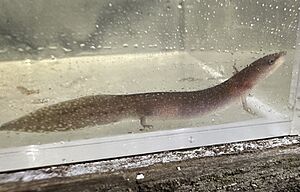Dwarf waterdog facts for kids
Quick facts for kids Dwarf waterdog |
|
|---|---|
 |
|
| Conservation status | |
| Scientific classification | |
| Synonyms | |
|
Menobranchus punctatus Gibbes, 1850 |
The dwarf waterdog (Necturus punctatus) is a type of salamander that lives only in water. It is found only in the Eastern United States. This salamander is the smallest member of its family, called Proteidae.
What Does It Look Like?
This salamander usually grows to be about 11.5 to 19 centimeters (4.5 to 7.5 inches) long. It has fluffy, narrow gills on its head, which it uses to breathe underwater. Its tail is flat, like a paddle. All of its feet have four toes.
The dwarf waterdog is usually a dark gray, brown, or olive green color on its back. Its belly is a dirty white color. Most of these salamanders do not have spots on their backs. If they do have spots, their belly will not have any. Young dwarf waterdogs are a plain brown color on their backs. Other young Necturus salamanders often have stripes.
Where Does It Live?
The dwarf waterdog lives in the eastern part of the United States. You can find it along the Atlantic coastal plain and the Piedmont regions. Its home range stretches from southeastern Virginia down to southcentral Georgia. Some salamanders found further west in Alabama and Florida might be a different, but similar, species.
Its Home Environment
Dwarf waterdogs like to live in slow-moving streams. They prefer streams with sandy or muddy bottoms. They also live in ditches connected to streams, and in cypress swamps. Sometimes, they can be found in old rice fields or mill ponds that are fed by streams.
These salamanders really like places with lots of fallen leaves and other plant bits on the bottom. In the winter, young waterdogs dig into the mud at the bottom. Adult waterdogs hide in beds of leaves.
How Is It Doing?
The dwarf waterdog is not considered to be in danger. It has a fairly large area where it lives. There are many healthy groups of these salamanders throughout most of their home range. They are not facing any big threats right now. Also, they live in several protected areas, which helps keep them safe.


